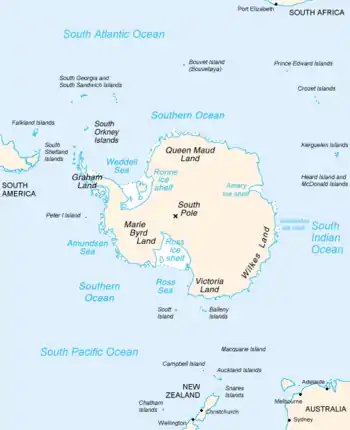Elliott Glacier
Elliott Glacier (66°33′S 115°14′E) is a small channel glacier that drains northward to the Budd Coast of Antarctica, midway between Cape Hammersly and Cape Waldron. It was delineated from aerial photographs taken by U.S. Navy Operation Highjump (1946–47), and named by the Advisory Committee on Antarctic Names after Samuel Elliott, a midshipman on the sloop Vincennes during the United States Exploring Expedition (1838–42) under Lieutenant Charles Wilkes.[1][2]
| Elliott Glacier | |
|---|---|
 Map of Antarctica, with Wilkes Land slightly to the right | |
 Location of Elliott Glacier in Antarctica | |
| Type | channel |
| Location | Wilkes Land |
| Coordinates | 66°33′00″S 115°14′00″E |
| Thickness | unknown |
| Terminus | Budd Coast |
| Status | unknown |
References
- "Elliott Glacier". Geographic Names Information System. United States Geological Survey. Retrieved 2012-02-28.
- "Elliott Glacier". Gna-GeographicNamesOfTheAntarctic1stEdition1981_djvu. p. 621. Retrieved 2012-02-28.
 This article incorporates public domain material from the United States Geological Survey document: "Elliott Glacier". (content from the Geographic Names Information System)
This article incorporates public domain material from the United States Geological Survey document: "Elliott Glacier". (content from the Geographic Names Information System)
| Types | |||||||
|---|---|---|---|---|---|---|---|
| Anatomy | |||||||
| Processes | |||||||
| Measurements | |||||||
| Volcanic relations | |||||||
| Landforms |
| ||||||
| |||||||
This article is issued from Wikipedia. The text is licensed under Creative Commons - Attribution - Sharealike. Additional terms may apply for the media files.